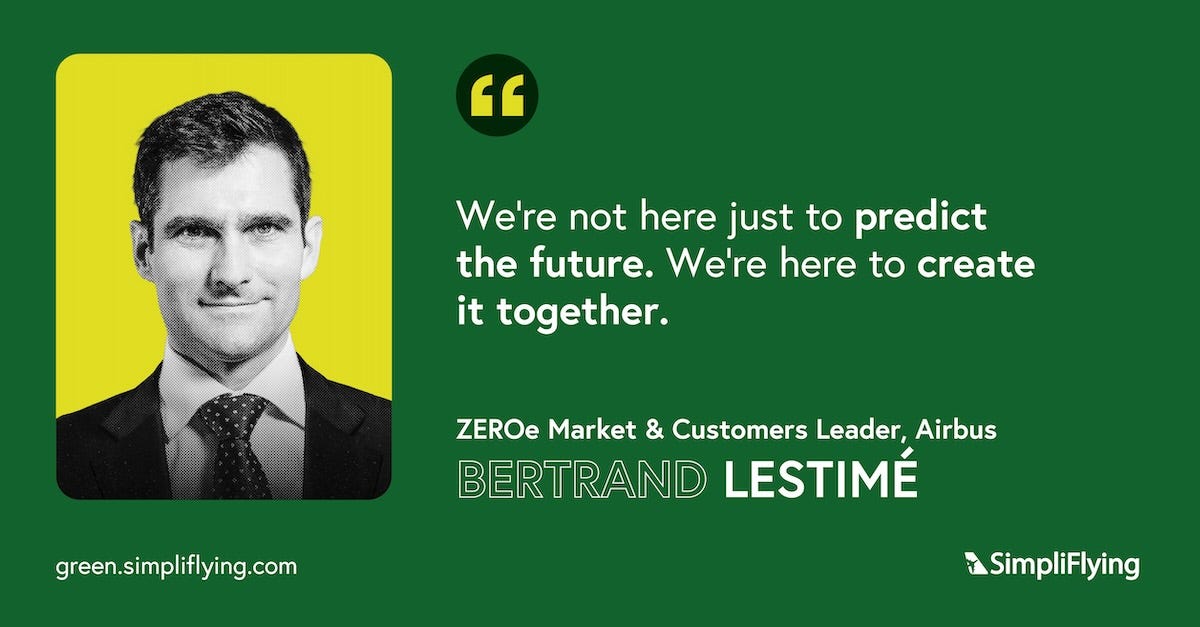In this episode of our ‘Sustainability in the Air’ podcast, Bertrand Lestimé, ZEROe Market & Customers Leader at Airbus, speaks with SimpliFlying CEO Shashank Nigam and outlines the airframer’s multi-pronged strategy to reach net zero.
Here are the key highlights of the conversation:
Airbus’ multi-faceted approach to sustainability (1:53)
The ZEROe initiative (3:57)
Creating hydrogen ecosystems through partnerships (5:16 & 17:26)
The potential of hydrogen in aviation and its challenges (9:07)
Lessons from the E-Fan project (24:24)
Project Blue Condor and non-CO2 effects (28:09)
Testing hydrogen-powered aircraft and payload reduction (32:48)
Rapid Fire! (41:09)
Keep reading for a quick overview of the episode.
Why promoting hydrogen in aviation matters
Conventional aviation fuels are major contributors to aviation’s CO2 emissions, and the transition to cleaner alternatives has become imperative. Airbus firmly believes that hydrogen has the potential to offer a true clean fuel solution.
As a fuel, green hydrogen offers significant environmental benefits, including potentially reduced NOx emissions and persistent contrails, especially with fuel cell usage.
The declining costs of green hydrogen, driven by wider adoption across sectors and economies of scale, present it as an increasingly viable option for decarbonising aviation, states Lestimé.
Hydrogen is energy-dense, and its energy density per unit of mass is ~3 times higher than jet fuel. Moreover, hydrogen can be utilised in various forms, including combustion, fuel cells, and as a component in producing synthetic sustainable aviation fuels.
Airbus believes hydrogen could play a significant role in its decarbonisation journey, contributing up to 50% towards achieving net-zero emissions in aviation by 2050.
5 ways Airbus is making hydrogen-powered flights a reality
1. Airbus’ multi-faceted approach to sustainability
Airbus has a multi-pronged approach to net zero which comprises “a basket of measures”, states Lestimé.
It includes fleet renewal with the latest, more efficient jets to significantly cut emissions.
Improving operational efficiency and air traffic management also plays a crucial role, offering significant CO2 reduction potential.
Sustainable Aviation Fuels (SAF) are another key component expected to contribute to cleaner aviation, adds Lestimé.
Airbus is also betting heavy on hydrogen and believes that it has the potential to offer a true clean fuel solution for aviation. Aligned with its beliefs, the aircraft manufacturer is developing hydrogen-powered aircraft through its ZEROe initiative.
“We will need to use a basket of measures meaning that they will not be just one single silver bullet. …it’s like stages on the rocket, the first one will be fleet renewal, second stage will be SAF and then there will be the ZEROe hydrogen-powered [aircraft], very much like on the Saturn V that used hydrogen on its third stage”
Furthermore, Airbus is investing in carbon removal technologies, has partnered with Carbon Engineering in British Columbia, and announced an agreement to purchase 400,000 tonnes of carbon removal credits from 1PointFive.
2. ZEROe – Airbus’ flagship hydrogen-powered aircraft project
Central to Airbus’ hydrogen strategy is the ZEROe project, a pioneering endeavour to make hydrogen-powered flights and clean air travel a reality.
Lestimé describes ZEROe as a potential game-changer that aims to develop hydrogen-fuelled aircraft and the necessary ecosystem to produce and supply hydrogen.
In 2020, Airbus revealed four concepts for zero-emission commercial aircraft that could enter service by 2035.
Of the four concept aircraft – all code-named ZEROe – three rely on hydrogen combustion, using gas turbines with modified fuel injectors and fuel systems powered with hydrogen. The fourth is a fully electrical concept powered by hydrogen fuel cells that create electrical energy to power electric motors that turn a propeller or fan.
In early 2022, Airbus also announced the ZEROe demonstrator that will test the potential of hydrogen-powered commercial flights on a modified A380 platform.
“There are two key foundations [of the ZEROe]: number one, the hydrogen-powered aircraft. Number two, the hydrogen supply, the economy, to ensure that when this aircraft enters the market in 2035, we can actually feed that fleet with green hydrogen at airports. So we have really to make sure that we create hydrogen hubs, hydrogen consortiums to provide green hydrogen at entry into service.”
3. Challenges associated with hydrogen
Despite hydrogen’s promise, its integration into aviation presents considerable challenges.
Hydrogen has a much lower volumetric energy density than conventional jet fuel. This means it takes significantly larger volumes of hydrogen to supply the same energy as jet fuels (or SAF), hence requiring more space to store enough energy to power flights, especially for long distances.
“We want to be really ambitious [in pursuing hydrogen], because we want to play a role in reducing our impact on climate. But we have to be very humble as there are challenges with hydrogen.”
While liquid hydrogen, which Airbus intends to use, tends to have better energy density than its gaseous counterpart, it needs to be stored at extremely low temperatures (-253°C). This would require specialised and heavy cryogenic storage systems, which would reduce the aircraft’s payload and range.
Airbus is tackling these challenges head-on with extensive testing and research. This also involves rethinking the aircraft design and storing fuel at the rear end of the fuselage.
4. Blue Condor project
In order to study the non-CO2 effects of hydrogen combustion in aviation, last year Airbus announced the Blue Condor project in partnership with the German Aerospace Research Institute (DLR).
Using a modified Arcus-J glider, the project will take a small hydrogen-combustion engine as high as 30,000 feet and compare its emissions to a similar-sized kerosene engine, flying alongside onboard a second aircraft. The project recently kicked off a test campaign with Airbus’ first hydrogen-powered flight over Nevada, US.
Blue Condor’s research will prove vital in understanding the environmental impact of hydrogen combustion on persistent contrails and NOx, and is a significant step in validating hydrogen’s feasibility as an aviation fuel.
“With the Blue Condor, we’re not testing the hydrogen combustion or the propulsion solution, it’s more about understanding the non-CO2 effects when we combust hydrogen. We think that potentially we could have fewer NOx, fewer persistent contrails… but we really have to make the measurements to make sure that this possibility is a reality. And there’s just one possibility here — to test, test and test.”
5. Creating hydrogen ecosystems through partnerships
The successful integration of hydrogen into aviation requires a collaborative ecosystem.
Airbus is a part of the Hydrogen South West, a cross-sector consortium of companies working to develop a hydrogen economy. The consortium has several projects planned to create links between supply and demand centres in the South West of England.
As one of the Hydrogen South West’s projects, Airbus has collaborated with easyJet, Bristol Airport and Hynamics to set up a potential “hydrogen hub” at Bristol Airport that can support its ZEROe initiative.
Additionally, Airbus is a member of the Hydrogen Consortium, which was launched at Christchurch Airport this year to set up a similar green hydrogen hub in New Zealand. Airbus is also a part of the Hydrogen in Aviation (HIA) alliance that aims to accelerate the delivery of zero-carbon aviation.
“The key idea is that by adopting green hydrogen as early as today, airports can decarbonise their own operations, because you will have plenty of consumers what we call the off-takers at the airport — the airport vehicles, the ground service equipment, ground transportation, air conditioning, etc, and then progressively we could ramp up so that there is sufficient supply from 2035. We think of the synergy where green hydrogen can be used by the airport in the first place, with a progressive ramp up to allow ZEROe operations from 2035.”
‘Sustainability in the Air’ is the world’s leading podcast dedicated to sustainable aviation. Through in-depth conversations with top aviation leaders, we break through the clutter and provide a clear roadmap for a net-zero future.
















